UN DESA | DPAD | Development Policy Analysis Division
** This page has moved permanently. If you are not redirected please click here: https://www.un.org/development/desa/dpad/document_gem/mdg-gap-task-force-report/ **
MDG Gap Task Force Reports
Millennium Development Goal 8
The MDG Gap Task Force was created by the Secretary-General of the United Nations to improve the monitoring of the global commitments contained in the Millennium Development Goals. The Report identifies implementation gaps to achieve the MDGs and provides recommendations to all major stakeholders on how to address these gaps.
The MDG Gap Task Force Report 2014: The State of the Global Partnership for Development
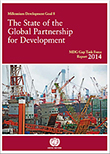
In its latest report, the MDG Gap Task Force found much progress towards achieving the goals set under MDG 8. There was a notable increase in official development assistance, a breakthrough in trade negotiations in Bali, an extension of duty-free and quota-free access to developed country markets for least developed countries, and greater availability and falling costs of telecommunications in developing countries. However, the report also highlights the many challenges that remain.
While official development assistance hit a record high, aid flows to some regions declined and total flows still fell short of commitments made by UN Member States; agricultural subsidies in Organisation for Economic Co-operation and Development (OECD) countries remain entrenched, small States continue to face longstanding debt sustainability challenges; and essential medicines continue to be unaffordable and insufficiently available in many countries. With the MDGs concluding in 2015, this report underscores the need for a renewed political commitment to development cooperation and to a coherent set of substantive policies for global development.
The MDG Gap Task Force Report 2013: The Global Partnership for Development: The Challenge We Face
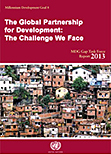
While there are advances to report in increasing access to new technologies and some essential medicines, in achieving greater duty-free access for exports from developing countries, and in completing the debt relief initiatives, the international community is not fully delivering on many of its commitments.
For the first time since 1997, official development assistance fell for a second year in a row; negotiations to reach an agreement on a development-oriented multilateral trade are stalled; more developing countries are in need of debt restructuring; and essential medicines are still unaffordable and insufficiently available in many countries. The differences in directions taken and the disparity in results weaken the cohesiveness of the global partnership. As many developing countries are redoubling their efforts to accelerate progress towards achieving the MDGs by 2015, more policy coherence and consistency is needed within the global partnership to support the endeavours of developing countries.
The MDG Gap Task Force Report 2012: The Global Partnership for Development: Making Rhetoric a Reality
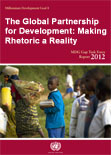
In its 2012 Report, the MDG Gap Task Force has had difficulty identifying areas of significant new progress towards delivering on commitments to the Global Partnership for Development, and for the first time there are signs of backsliding. The volume of official development assistance (ODA) fell for the first time in many years, obstacles to exports from developing countries are on the rise, and numerous developing countries are facing debt difficulties. With less than three years until 2015, there is no apparent commitment by donor Governments to reverse the trend in time, and it is likely that fewer MDGs will be reached in fewer countries as a result.
The Report finds that the protracted global economic crisis has begun to take its toll on international development cooperation. With a $167 billion gap between actual aid disbursements and the amounts committed, total ODA should more than double in order to meet the UN target. A delayed impact of the economic crisis on donor country budgets threatens to further widen this gap. Negotiations under the Doha Round for a fairer multilateral trading system remain at an impasse eleven years after they started, and the current economic situation has lured Governments back into using protectionist trade policies.
There has also been limited progress in fulfilling other key aspects of the global partnership for development. Despite the poorest countries receiving generous debt relief, many still face unsustainable obligations. And while new financing has been pledged to some disease-specific global health funds, there has been little improvement in recent years in increasing availability and affordability of essential medicines in developing countries. To address the current situation, the MDG Gap Task Force calls upon the international community to honour its promises and close the gaps between commitments and delivery.
The MDG Gap Task Force Report 2011:
The Global Partnership for Development: Time to Deliver
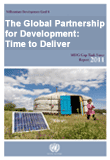
Significant gaps remain in delivering on the commitments in the areas of aid, trade, debt relief, and access to new technologies and to affordable essential medicines. A number of crucial commitments that were supposed to have been reached by 2010, including increased aid volume, improved aid effectiveness, and the conclusion of the Doha Round of trade negotiations, have not been met. The MDG Gap Task Force Report 2011 monitors the progress made in achieving the targets of MDG 8, including continued attention to the impact of the global crisis on meeting the targets set under MDG 8 and embedding any new commitments resulting from the High-level Plenary Meeting of the sixty-fifth session of the General Assembly on the MDGs into the monitoring process. Policy coherence is a central theme of the 2011 issue of the Report paying attention not only to issues of coherence across the various dimensions of the global partnerships, but also on the extent to which those partnerships are aligned behind national development strategies for achieving the MDGs. The adequacy of international support measures especially for least developed countries, particularly with regards to trade preferences and debt relief are analysed. With less than four years left until the 2015 deadline to deliver on the commitments contained in the MDGs, the 2011 Report provides recommendations to all major stakeholders on how to address the remaining implementation gaps.
The MDG Gap Task Force Report 2010: The Global Partnership for Development at a Critical Juncture
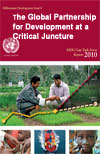
In September 2010, world leaders will take stock of MDG achievements to date at the High-level Plenary Meeting of the United Nations General Assembly. Much progress has been made since 2000, but there is still a great deal more to be achieved in order to fulfill the promise of the MDGs. In this sense, the global partnership for development stands at a critical juncture, with only five years left until the 2015 deadline to deliver on the commitments made and to achieve the MDGs. Remaining gaps are still very large and there have been setbacks because of the global food, energy and financial crises. The deadline for commitments in a number of crucial areas (including increased aid volume, improved aid effectiveness, and the conclusion of the Doha Round of trade negotiations) is 2010, but there is little prospect of successful delivery.
The 2010 issue of the report identifies the implementation gaps in the commitments made under MDG 8 and provides recommendations on how to address them, on strengthening the global partnership, and ultimately supporting developing countries in achieving the MDGs.
The MDG Gap Task Force Report 2009: Strengthening the Global Partnership for Development in a Time of Crisis
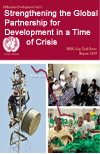
Further progress has been made towards fulfilling the promises embodied in the Millennium Development Goal 8 (MDG 8). However, the Global Partnership for Development has suffered important setbacks, most of which have arisen from the current state of the world economy which is experiencing its severest downturn since the Great Depression of the 1930s. Important gaps remain in delivering on the global commitments in the areas of aid, trade, debt relief, and access to new technologies and to affordable essential medicines. In the countdown to 2015, urgent responses are needed to bridge the existing implementation gaps to make good on the promises made to achieve the Millennium Development Goals.
The 2009 issue of the A recently released report by the United Nations Millennium Development Goals Gap Task Force identifies these gaps in detail and provides recommendations to all major stakeholders on how to address these gaps.
The MDG Gap Task Force Report 2008: Delivering on
the Global Partnership for Achieving the Millennium
Development Goals

Important gaps remain in delivering on the global commitments in the areas of aid, trade, debt relief, and access to new technologies and to affordable essential medicines. In the countdown to 2015, urgent responses are needed to bridge the existing implementation gaps to make good on the promises made to achieve the Millennium Development Goals.
A recently released report by the United Nations Millennium Development Goals Gap Task Force identifies these gaps in detail and provides recommendations to all major stakeholders on how to address these gaps.